B2B (Business to Business)
Definition
This glossary page was last updated on August 30, 2022.
Definition
B2B (Business to Business) is when a business buys or sells to another business rather than an individual consumer (Business to Consumer/B2C). B2B businesses target other businesses to sell their product or service to.
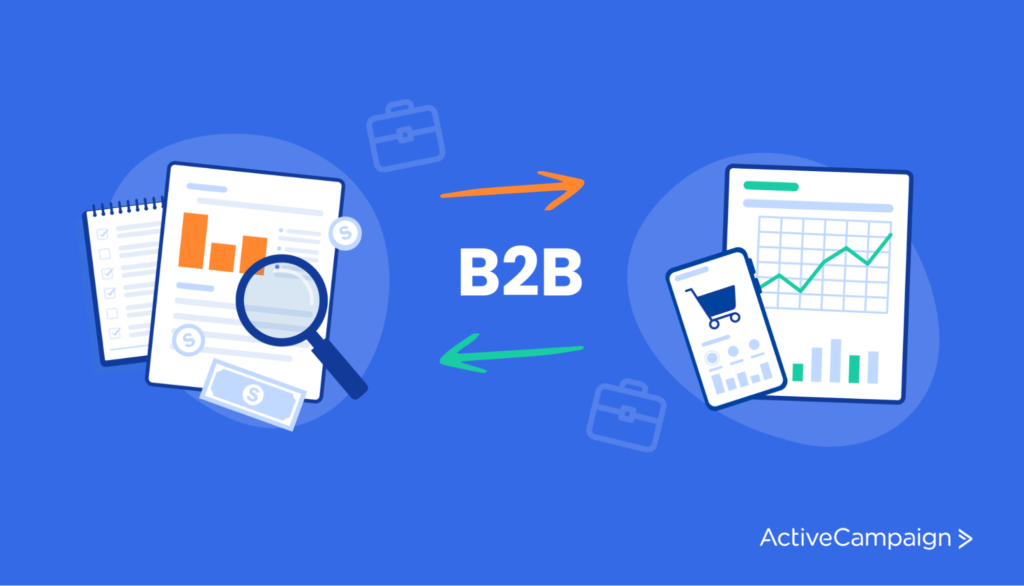
Often, B2B businesses sell raw materials to manufacturers before finished products are sold to consumers. Examples of B2B businesses are food supply companies, electronic component manufacturers, and logistics companies.
Table of Contents
What is B2B vs. B2C?
B2B stands for business-to-business, whereas B2C stands for business-to-consumers.
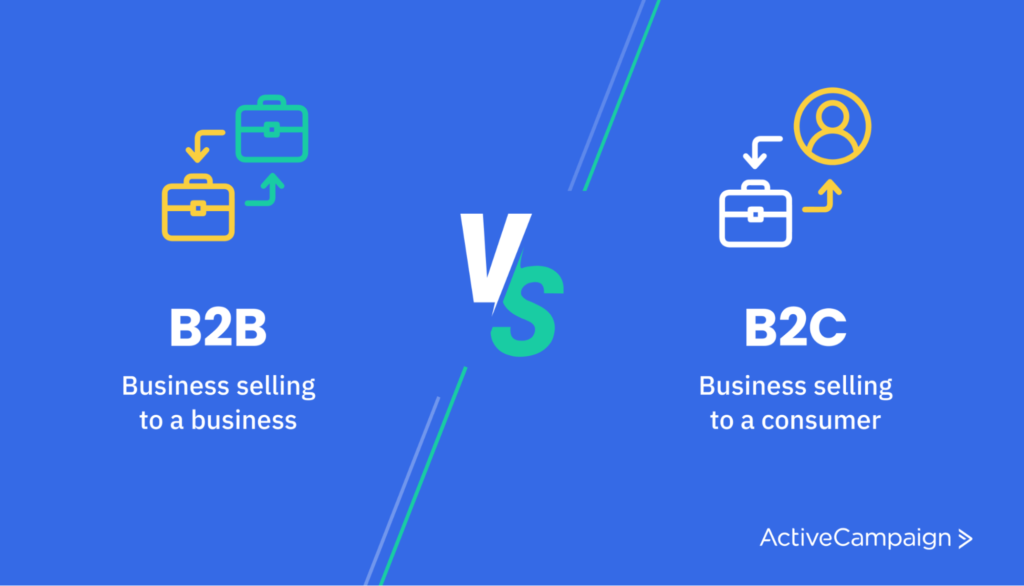
So, a B2B business sells products and services to other businesses, while a B2C business sells products and services to customers for personal use.
Though B2B and B2C companies have a lot in common (at the end of the day, they’re both selling some form of product or service to a person), many aspects of sales, marketing, and engagement with potential customers differ.
What do B2B companies do?
At the highest level, B2B companies sell their products or services to other businesses; that’s really all that separates them from other companies.
Like their B2C counterparts, B2B organizations consist of several moving parts.
Product
Product teams are responsible for building the thing the company sells.
For example, the product team at a company selling a CRM tool would be responsible for understanding market needs, analyzing current usages (to inform changes), developing new features, and collaborating with marketing teams to develop product positioning and messaging.
Marketing
The primary responsibilities of the marketing team in a B2B company are to improve brand awareness, attract new customers, and open the gateway to a conversation with a sales team member.
More specific activities include:
- Engaging in audience and customer research to understand core purchase motivators
- Creating content to educate their audience and grow the company’s online presence
- Designing offers like free trials and lead magnets to fill the sales pipeline
- Nurturing early-stage leads
- Supporting the sales and customer success teams with content creation
Sales
A B2B sales team's structure differs significantly based on the company’s revenue model.
If they’re taking a product-led approach, sales are generally fairly self-service. That is, a customer can head to a brand’s website, click sign up, and get started using the product without ever engaging with a sales rep.
More common, however, is a structure that includes Sales Development Reps (responsible for prospecting and appointment booking) and Account Executives (responsible for sales demonstrations, negotiations, and closing deals).
Customer service and success
Once the sales team has closed a new client, customer success steps in to help guide them and ensure they get the most out of a product, aiming to improve customer retention.
Customer service (or support) is more focused on providing technical assistance.
Operations and administration
The operations and administration teams in a B2B organization fill in the blanks. Admin teams work on tasks like database management and invoicing, and operations teams may support product delivery, depending on the company’s product or service offering.
What are the main characteristics of B2B?
The most obvious characteristic of the B2B environment is that businesses interact with each other rather than end consumers.
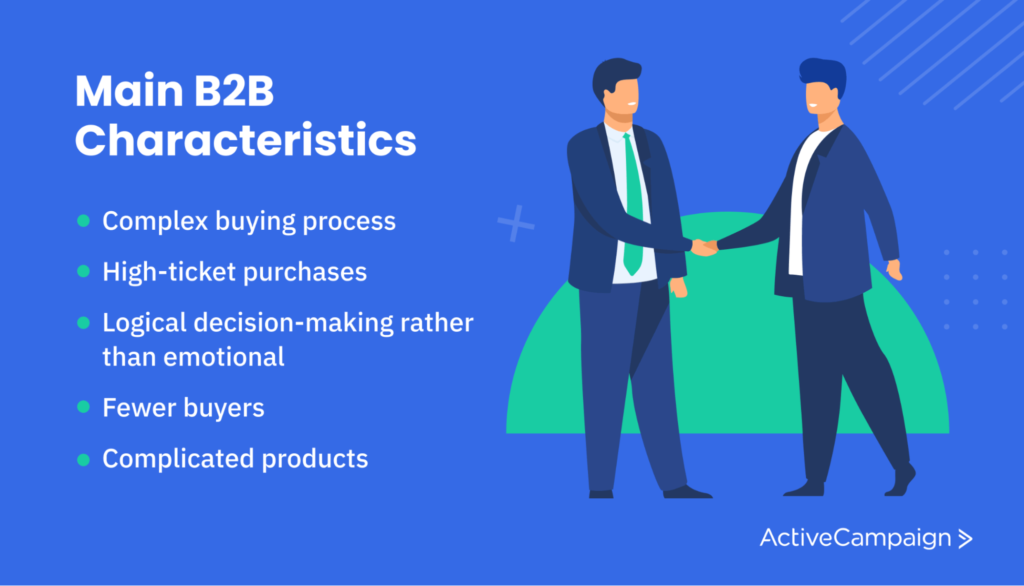
However, a few other aspects delineate B2B businesses from B2C.
Complex buying process
B2B buying processes tend to be more complex than in B2C.
In B2C, a consumer recognizes a need, figures out how to solve it (a product), then decides to buy it.
In the B2B world, purchase prices tend to be much higher (even a $30 per seat product costs $30k per month if you have 1000 employees), and many customers have complicated approval processes and buying committees who must be convinced.
There are also often long periods of consideration (e.g., research and weighing up competitors), negotiation, and integration.
High-ticket purchases
B2B sales are often in the thousands of dollars, sometimes reaching into the millions over a contract period.
Many business-facing SaaS products are sold on a subscription basis, using a per-user pricing model.
To illustrate, imagine a product with a $79 per user per month price point. For a company with 2000 employees (assuming every employee needs a license for this product), that’s an annual cost of nearly $2m.
Logical decision-making rather than emotional
Generally, B2B purchases are driven more by logic than emotion.
Emotions do play a part in B2B decision-making; you’re still dealing with people who have a problem (a work problem rather than a personal one), and your solution will have a personal and emotional impact.
However, due to long sales cycles, high ticket prices, and the existence of enterprise buying committees, logic and financial analysis (i.e., how much will this investment save or make us?) tend to take the front seat.
Fewer buyers
B2C products can often be marketed to millions of people. Take Coca-Cola. Virtually everyone is their target audience.
For B2B, that market segment is a lot narrower. This is a blessing and a curse. The limited market potential can be challenging but can also make it easier to determine how to position and market your product.
Complicated products
A B2C product like Uber is easy to comprehend. You want to go somewhere, you pay the app, and they pay the driver.
With business-facing products like cloud security and enterprise resource planning, things are a lot more complex, meaning sales teams often include a specialized role known as the Sales Engineer to explain technical aspects.
Why do businesses sell B2B?
In some cases, the decision to sell B2B isn’t so much a choice as a necessity; it’s the only audience a company’s product suits.
For example, a company with a sales CRM wouldn’t be able to sell their product to a B2C audience; only other businesses get use out of their product.
Other companies can be both business and consumer-facing.
Take Box, for example.
Box—a cloud-based content management and collaboration tool—offers free and paid plans for individuals and has an extensive B2B offering. In this case, they’ve chosen to sell B2B because they can reach a larger market, which is why businesses decide to incorporate a business-facing offer.
What is an example of B2B?
ActiveCampaign is a perfect example of a B2B company. Other examples of B2B brands include:
- Xerox
- Dropbox
- Slite
- Toggl Track
- IBM
- Zoom
- Adobe
- WeWork
What are the advantages of B2B?
The B2B business model offers many advantages.
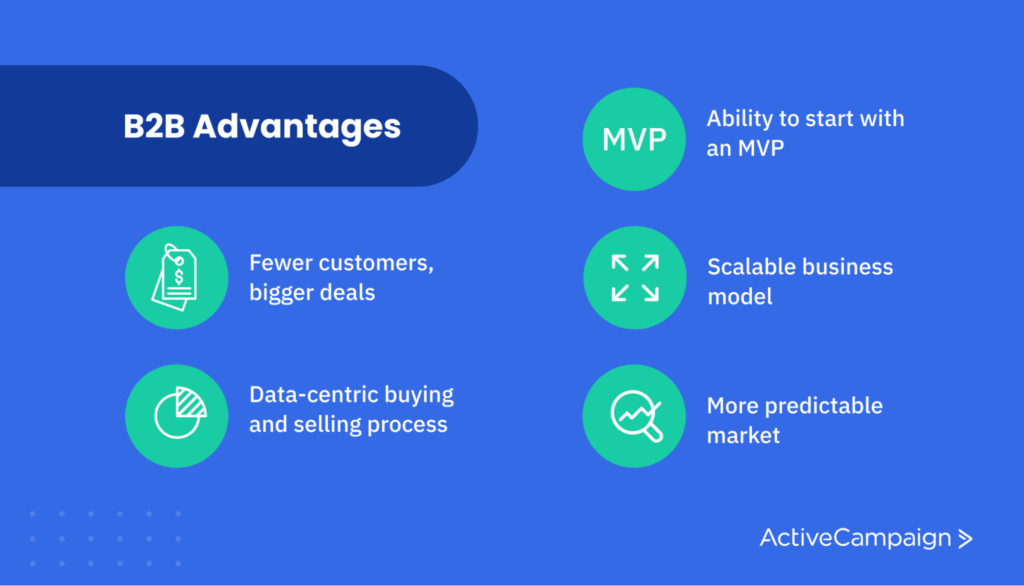
These include:
- Higher revenue from each deal, meaning companies can exist with fewer clients than if they were serving B2C customers.
- A highly-scalable business model (if 1 or 2 B2B customers have a strong need for your product, you’ll likely be able to reach a larger target audience with a strong B2B marketing strategy)
- The ability to start with an MVP (minimal viable product). Many B2B audiences will be happy to start using a product with minimal functionality if it solves a crucial problem.
- Data-centric buying and selling process (meaning as a business owner or leader, you can more easily identify what motivates decision-makers and then sell directly to those influencers)
- More predictable market (B2B buyers tend to be less fickle than B2C markets)
What are the disadvantages of B2B?
Of course, selling in the B2B marketplace also has its share of challenges.
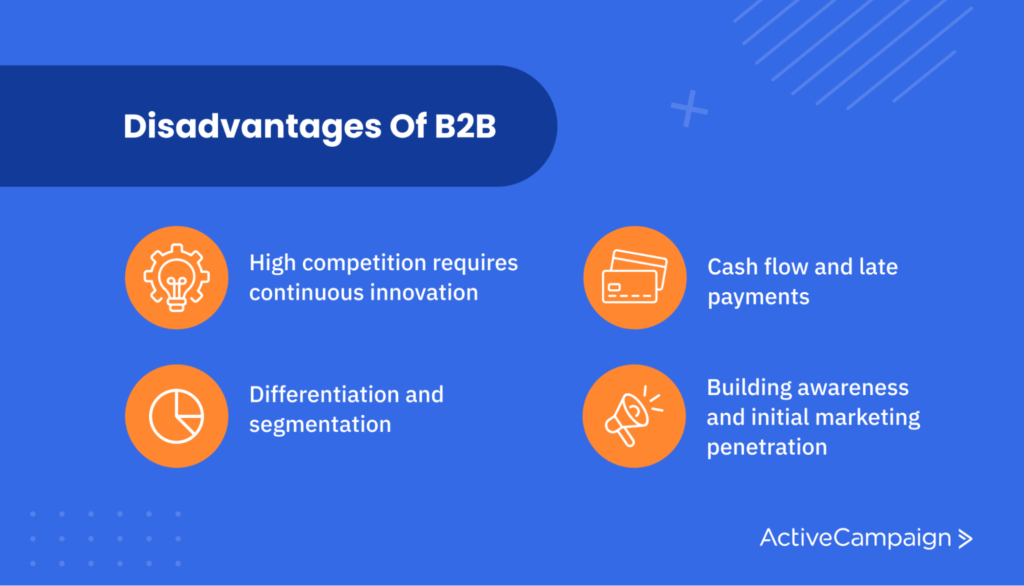
These include:
- High competition, meaning that staying competitive in B2B environments requires continuous innovation
- Differentiation is challenging when competitors can easily replicate your new features
- Cash flow and late payments (B2C transactions are generally upfront, whereas for B2B transactions and terms of payment vary, meaning cash often isn’t received immediately)
- Building awareness and initial marketing penetration can be difficult, especially in crowded verticals.
What is a B2C example?
Some popular examples of well-known B2C companies include:
- Uber
- Walmart
- Toyota
- Apple
- Netflix
- Amazon
- Coca-Cola
- Spotify
- Airbnb
Is Amazon a B2B or B2C?
Amazon is a unique case in that it has B2B offerings (hosting and fulfillment), B2C offerings (marketplace), and C2C offerings (secondary sellers marketplace).
What’s better: B2B or B2C?
Neither B2B nor B2C is better overall. Each option has its pros and cons, both in general and for each product or service offering.
Some products or services may also only be suitable for 1 method.
What is B2B sales?
B2B sales are complex, particularly as businesses target enterprise-level companies (like the Fortune 500 list).
While each organization will tackle things slightly differently and thus have different sales teams and process structures, there are some commonalities across the board.
How do B2B sales work?
There are 2 main styles of B2B sales:
- Inbound sales
- Outbound sales
Inbound sales is intimately connected with the marketing team.
Marketing is responsible for generating B2B sales leads (prospective customers), then nurturing them to a point where they show enough interest to be considered “sales-qualified.” At this point, the sales team takes over.
Sometimes, this is customer-led, for example, when a customer books a demo meeting on a company's website.
Outbound sales essentially involve sales reps cold calling other businesses (or cold emailing or social media messaging), explaining the value of their product, and asking to book time for a meeting to discuss their partnership further.
The typical B2B sales process looks something like this:
- Lead generated (either through outbound cold calling or inbound marketing)
- Prospecting and research
- Qualification (determining if the 2 companies are a good fit)
- Presentation (demonstrating the value of a product or service)
- Objection handling
- Negotiation
- Closing
What is a B2B sales example?
Let’s say your company is an ecommerce clothing retailer. You’re a B2C company with a database of around 20,000 previous customers.
You’d like to improve your communications with previous customers, implementing an email marketing strategy to promote new items and encourage repeat sales.
To put this into play, you’ll need an email marketing platform.
So, you engage in online research, identify the best option for your needs (ActiveCampaign, right?), and book a demonstration.
Before the demo call, a Sales Development Rep calls to ask a few questions about your company and needs so the Account Executive can prepare a personalized presentation. While this may be true, they also perform a qualification process to ensure the product is a good fit for you.
You meet with the AE, learn about the product, decide it’s the right fit for your needs, and sign a contract.
That’s a B2B sales process.
[free-trial headline="Make The Most Out Of Your B2B Marketing" description="Get started creating automation targeting your b2b clients with a 14-day free trial of ActiveCampaign."]What is the difference between B2B sales and B2C sales?
There are many differences between a B2C and a B2B sales strategy:
- B2B sales reps tend to have more specialized roles
- B2C sales cycles are generally shorter
- B2B sales are typically more logical than emotional
- B2C sales are often customer-led (not requiring a sales agent at all)
- B2B sales processes are generally more complex
What are the 3 most important qualities of a successful B2B salesperson and why?
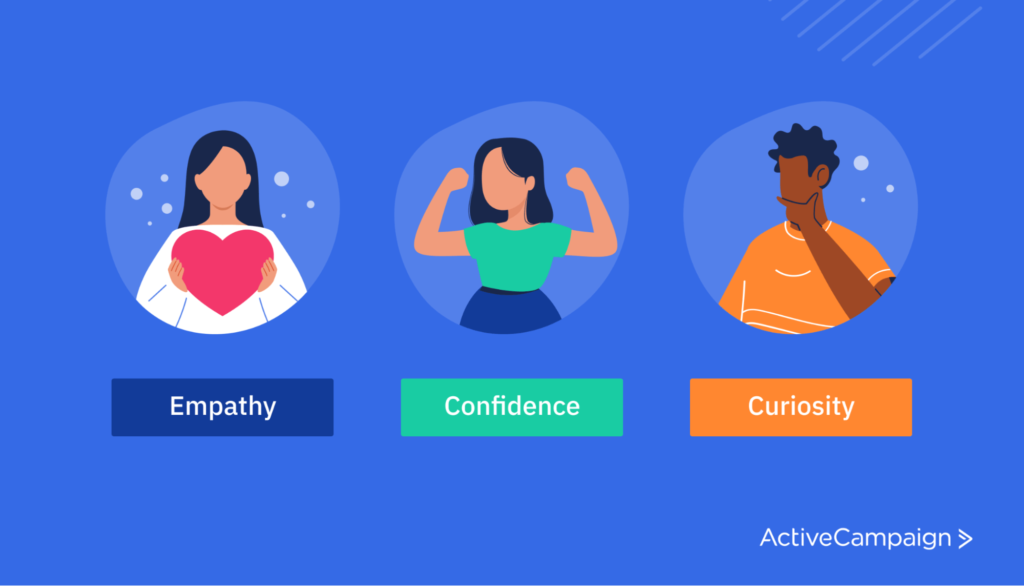
1. Empathy
Empathy is crucial for building trust with a customer and demonstrating that you genuinely understand their position, challenges, and impact on their daily lives.
2. Confidence
Buyers resonate with confidence. A sales rep who lacks confidence gives the impression of uncertainty and disingenuity, making it difficult for buyers to trust.
3. Curiosity
Sales agents must be curious about a customer’s current circumstances and about how they’ll be able to help.
This genuine curiosity leads to smooth-flowing conversations that explore a customer’s pain points rather than an interrogation or series of scripted questions.
What is B2B Marketing?
B2B marketing is the process of marketing a product or service to a business audience.
How does B2B marketing work?
B2B marketers use many strategies to reach their audience. Today, B2B marketing is primarily inbound and digital (meaning it’s strongly content-based). However, more traditional methods like billboards and B2B events do exist.
Each company will have a different process for attracting customers. However, the typical B2B customer journey and accompanying marketing process look something like this:
- A customer becomes aware of a problem and begins their research process.
- During their search, the customer comes across some content a relevant business has produced (often a blog post on a topic related to the customer’s problem).
- The customer looks further into the company and understands they are a potential solution.
- The company uses retargeting tactics to promote more content in the customer’s social media feed.
- The customer downloads a relevant ebook, guide, or other lead magnet.
- The company now initiates a lead nurture email sequence, distributing more content to educate the customer, ending in a request for a demo.
- The customer books a sales demonstration, and the process moves over to the sales team.
What is a B2B marketing example?
This sponsored Facebook ad from Chargebee, a subscription billing platform, is a great example of B2B marketing.
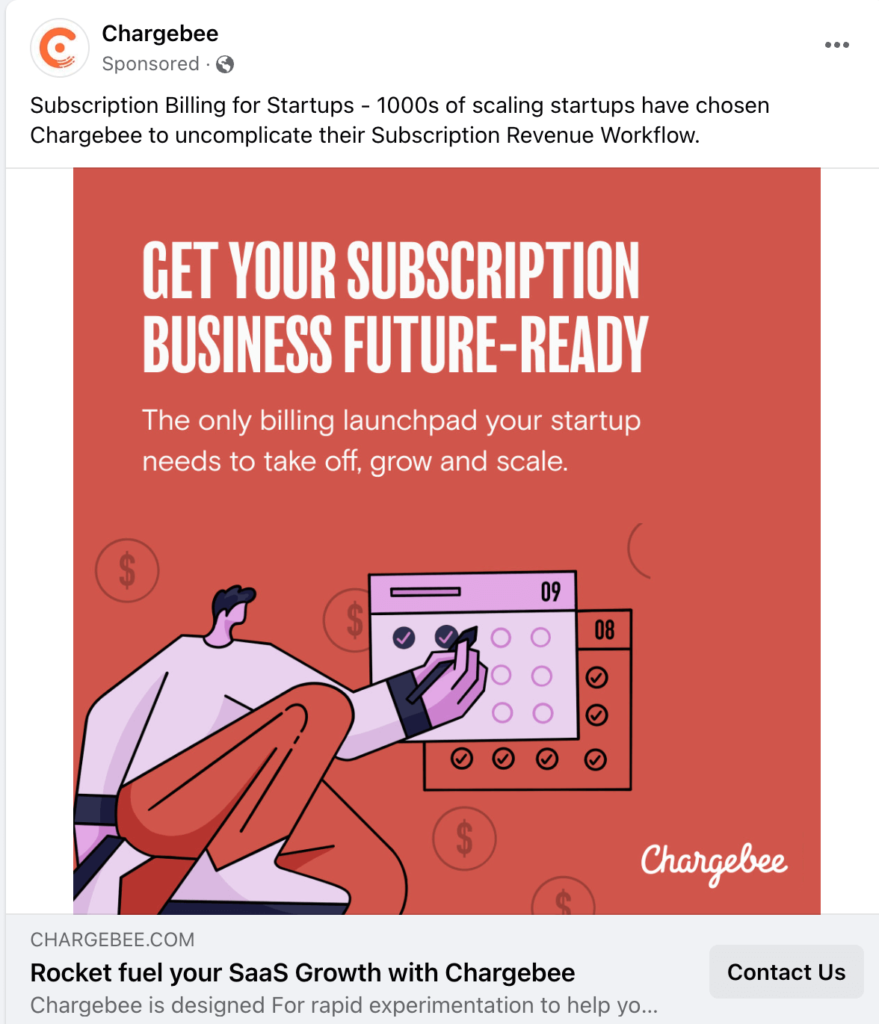
What is the difference between B2B marketing and B2C marketing?
Aside from the obvious difference in audience, the main difference between B2B marketing and B2C marketing is that B2C tends to focus on appealing to an emotion or feeling, whereas B2B marketing is more often tailored to specific business challenges and desires (like cost reduction or revenue growth).
What tactics are involved in B2B marketing?
B2B marketers use a variety of tactics and typically combine several for an omnichannel approach.
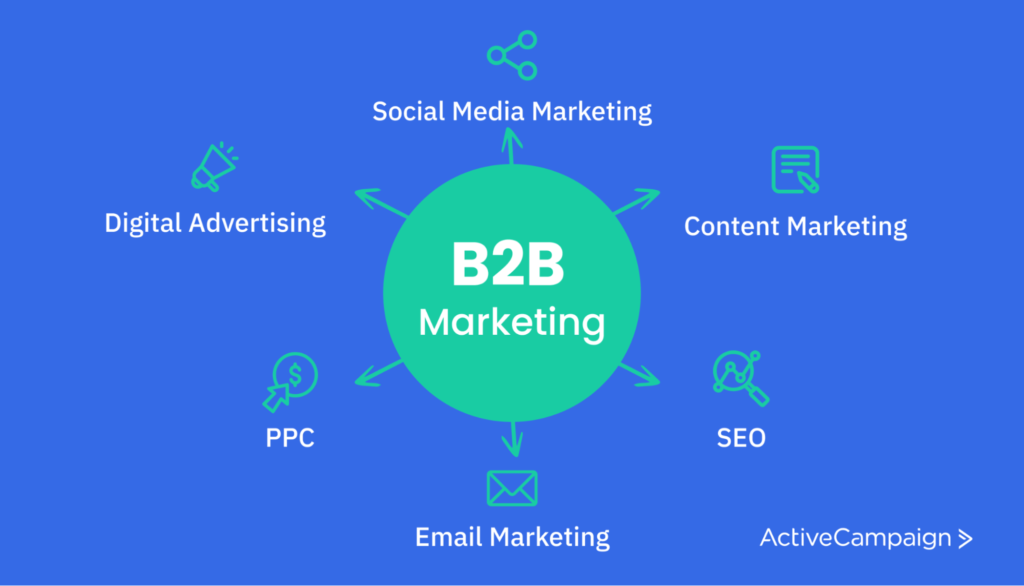
The specific tactics used will depend on the customer’s industry. For instance, a B2B ecommerce brand might focus more on social media, while a B2B IT service provider might engage more in PPC and digital advertising.
Content Marketing
A B2B content marketing strategy focuses on attracting new prospective customers by creating and distributing educational content, such as:
- Blogs posts and articles
- Videos
- Infographics
- Whitepapers
- Ebooks
- Guides
- Webinars
Content marketing forms the foundation of many B2B marketing strategies, with the content itself being distributed using other channels mentioned below, such as email, social media, and SEO.
SEO
SEO stands for search engine optimization. It's a digital marketing tactic that involves optimizing written content (such as web pages and blog posts) for search platforms like Google.
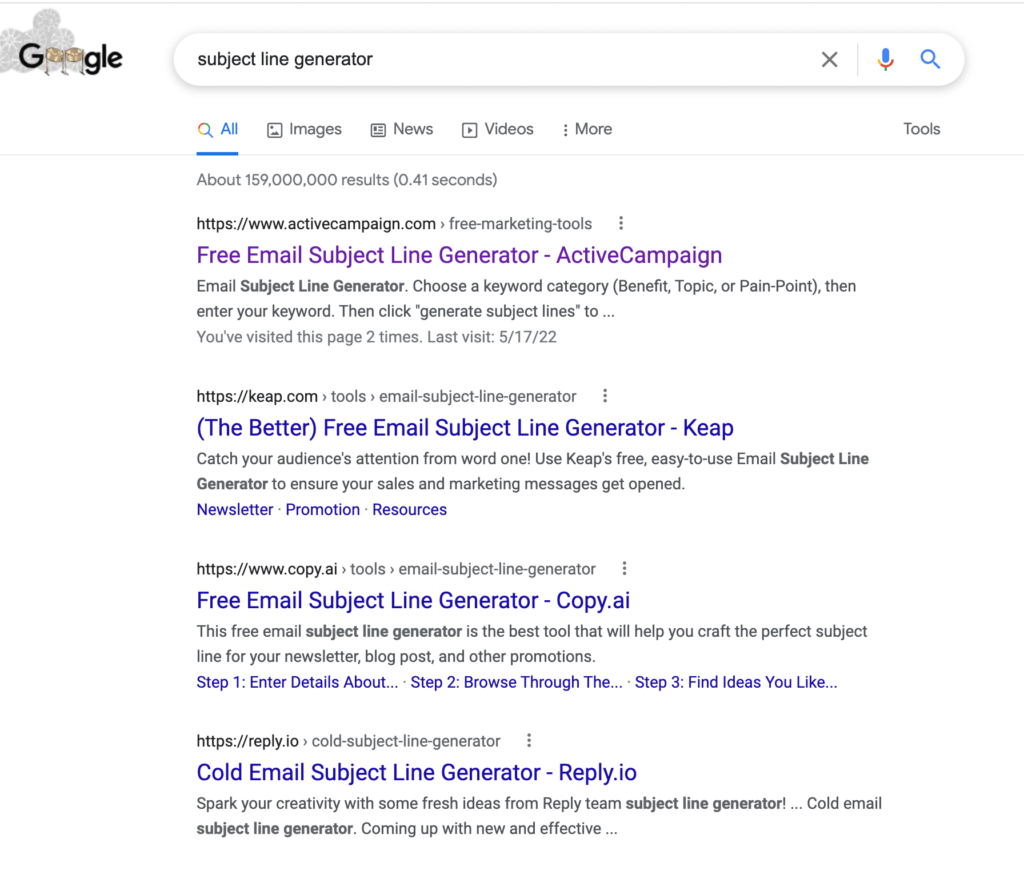
For instance, our free email subject line generator web page is optimized for the search term “subject line generator,” so it shows up in position 1 in a Google search for that phrase.
Digital Advertising
Digital advertising refers to online billboards found in ad spots on other sites (in this context, often B2B websites).
For example, Clearscope, a content optimization tool, might run an ad on ContentWritingJobs.com, a job ad platform, to reach potential customers with a need for their product.
Social Media Marketing
Social media marketing is a huge strategy in itself and encompasses a variety of tactics, including:
- Organic social (posting on your company's pages)
- Audience engagement
- Running or engaging in social media groups
- Paid social (running sponsored ads)
PPC
PPC stands for pay-per-click, and it's the practice of advertising within a search engine.
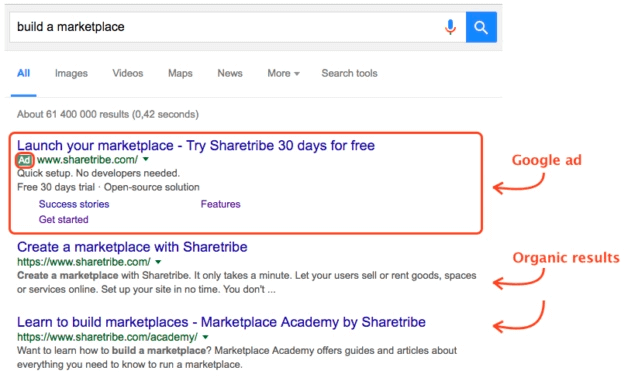
With PPC, companies bid for a specific keyword, say “build a marketplace,” and whoever bids the highest gets their ad placed at the top of a SERP (search engine results page).
Email Marketing
Email marketing is another broad practice. In most cases for B2B companies, email marketing is used to nurture leads that aren’t ready to engage with a salesperson yet, and increase engagement with current customers to improve retention.
How to get the most out of B2B
Selling B2B requires specific skills, but even the best B2B marketers and salespeople have a little help: a powerful automation platform.
Learn how ActiveCampaign can transform your B2B sales and marketing campaigns here.